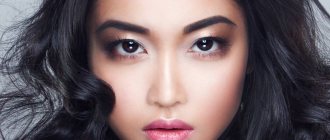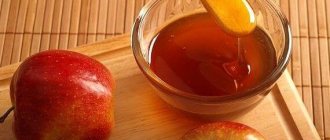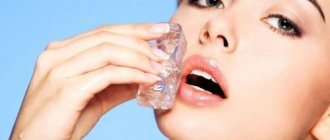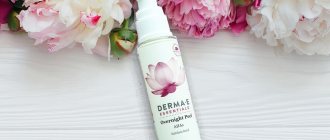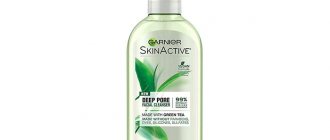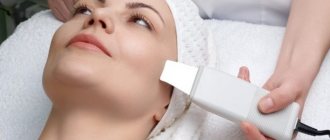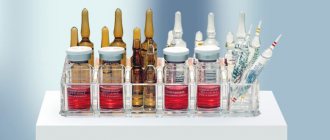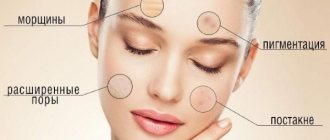Facial anatomy
The face, like many other tissues, undergoes sagging processes under the influence of gravity. This process is called gravitational ptosis. I propose to consider the anatomy of the face layer by layer. It is a layer-by-layer description of facial anatomy from the perspective of the concept of Australian surgeon Brian Mendelson that will help to understand the mechanisms of aging.
Essentially, the face consists of 5 layers: skin, fatty tissue, muscles, ligaments, periosteum and facial skeleton.
- The skin is the outermost layer. Traditionally, facial aging is associated with skin changes, so most treatments begin with skin care. Many people use creams, masks, etc. It really has a positive effect. However, up to a certain age. According to various authors, facial aging begins at the molecular level on average at the age of 30. This process occurs deep in the structures of the skin, so all rejuvenation procedures are essentially care and do not have a long-lasting effect.
- Subcutaneous tissue. Lies under the skin and consists of adipose tissue. The thickness of the fat layer varies in different parts of the face. With age, fat sinks and accumulates in certain places, forming bags under the eyes, jowls, etc.
- Muscles . There are 21 facial muscles on the face. With age, muscles weaken and sag, like a hammock in which fat accumulates. In this regard, working exclusively with the skin will not help achieve aesthetic rejuvenation. After all, even after performing a skin tightening, an array of muscles and adipose tissue will stretch the face and the result of skin procedures will disappear in no more than 1 year.
- Ligaments . With the help of ligaments, the soft tissues of the face are attached to the facial skeleton and are located in certain places. Time and gravity have virtually no effect on the ligaments, so weakened muscles and hanging fat are thrown over the ligaments, forming pronounced age-related contours of the face.
- Periosteum and facial skeleton. The bony skeleton determines the shape of the face and the very uniqueness and individuality of our faces. However, over time, the bone tissue slowly collapses, which creates the preconditions for the heavy mass of the face to slide down.
Rice. 1. Layers of the face according to Mendelssohn
Rice. 2 Mendelssohn's ligaments
Rice. 3 Young and old face
Correction of age-related changes
With age, multifactorial processes occur that determine the aging process of the face. These processes affect the facial skeleton and integumentary tissues. After 30 years, the beginning changes in the face are already visually noticeable. Changes in all tissue layers lead to their displacement and downward movement. More pronounced processes occur in the middle third of the face. The decisive factor in the drooping of the integumentary tissues of the face is a change in the bone surface.
- Forehead
Flattening of the frontal bone, combined with constant tension of the frontal muscle, leads to drooping of the integumentary tissues of the upper area of the face and the formation of transverse grooves in the forehead. The sliding mass of soft tissues of the forehead forms excess tissue in the area of the upper eyelids, the tails of the eyebrows droop and a “heavy” look is formed.
- Middle face area
Atrophy of bone tissue and fat packets in the midface area, combined with weakening of the muscles, leads to contusion of the ligaments and grooves. Pronounced bags under the eyes and eye bags form.
- Neck
The framework that holds the tissues of the lower zone of the face is the platysma - the subcutaneous muscle of the neck. Atrophy of the jaw bone, prolapse of the submandibular salivary gland, together with weakening and divergence of the platysma fibers, form an obtuse cervical-mental angle and a “double chin.” Thus, with age we observe: a reduced lower jaw; a stretched space at the bottom of which fat has accumulated; atrophied neck muscles that can no longer hold soft tissue and sag under gravity; the resulting jowls.
Fig.1 Aging according to Mendelssohn
Rice. 2 Bone atrophy according to Mendelssohn
Rice. 3 Facial aging: pronounced folds, jowls, “fat packets”
There are 5 types of facial aging:
tired,
finely wrinkled,
deformational (ptotic)
combined (mixed)
and muscular.
Maria Dmitrievna Klimenko, cosmetologist (Moscow), talks about the combined type of aging:
Combined type
aging combines both fine wrinkled and ptosis types. That is, all the signs of age and gravity appear on the face: bags under the eyes, and sufs, and jowls, and a double chin, and pigment spots, and rosacea, and a network of wrinkles, and a thickened stratum corneum, manifested by dullness of the skin.
The combined type of aging is characteristic of both Slavic and South Russian types of faces. A typical sign is pronounced fat bags that slide down with age. Photoaging occurs when exposed to the sun. Thus, the cosmetologist’s task is to return the lost contours to the face and work with the surface (skin quality).
Correction of combined type of aging:
Stage 1 – placement of absorbable threads.
The threads allow you to move fat packets upward relative to the bone structures. As a result, we get a slight lifting - the oval of the face becomes more toned, V-shaped, and after 3-6 months the fat packets decrease in volume.
The action of the threads has a very positive effect on the skin, increasing the production of its own collagen. The effect also increases over 3-6 months and lasts quite a long time. The threads degrade within 200 days, but I observe the effect on patients within 1.5-2 years.
In the middle part of the face, the effect of mesothreads is very noticeable. But on the second chin it is much more modest - it is better to tighten it with Aptos threads. Jowls can be corrected with long mesothreads with notches, and they can be additionally reinforced.
I believe that threads are indicated and effective for any type of aging. Properly selected and correctly placed threads give excellent results on both puffy and thin faces.
Of course, with the deformation-edematous type, it is preferable not to use 3D mesothreads made of polydioxanone, but to use more powerful lifting techniques - Aptos threads made of caprolac, which have a fixation point, even if it is movable. Combinations of thread techniques with fillers and botulinum toxin come to the fore here. This is the gold standard of cosmetology.
This is not a public offer! There are contraindications. Before use, consultation with a specialist is required.
Stage 2 – correction with fillers.
Fillers allow you to remove uneven terrain, correct folds and wrinkles, by which we evaluate signs of aging. As a rule, the central part of the face is corrected - nasolabial folds, nasolacrimal and nasobuccal grooves. Less commonly, fillers are placed in the corners of the lower jaw, the lateral parts of the eyebrows and the temporal parts, which allows you to restore the clarity of the contours, replenish lost volumes and make the face more youthful and rounded.
Stage 3 – improving skin quality.
The third stage is working with the surface: improving the quality of the skin, removing excess pigment and dilated blood vessels.
To do this, we use the entire hardware arsenal of cosmetology: photorejuvenation technologies, laser rejuvenation. The Candela Alexandrite laser perfectly removes pigment spots. Couperosis can be removed using a neodymium laser, as well as dye lasers and the QuadroStar Pro Yellow laser. Indirectly, lasers improve collagen production in the skin, stimulate fibroblasts, and narrow pores.
We also include resurfacing lasers for working with the skin surface: CO2 or erbium. They reduce the thickness of the stratum corneum and visually the surface acquires the gloss inherent in young skin.
Biorevitalization now acts not as a monoprocedure for older people, but as an auxiliary rehabilitation procedure for laser resurfacing, photorejuvenation or work with blood vessels.
Also read:
“Lifting by a cosmetologist” “Why has Botox become worse?” “Appearance problems through the eyes of a therapist, endocrinologist, hematologist” “Aging: the neck area” “Paint bags on the cheekbones: how to get rid of them”
This is not a public offer! There are contraindications. Before use, consultation with a specialist is required.
How to slow down facial aging?
Facial aging is a multifactorial process manifested in bone resorption, changes and sagging of the soft tissues of the face. Procedures for external influence on facial skin are essentially care products that do not bring the proper rejuvenating effect.
- Superficial treatments: creams, ointments, gels and other procedures moisturize and maintain skin condition.
- Injection techniques: fillers and botulinum toxin. Fillers based on hyaluronic acid help fill the volume of tissue that has undergone atrophy, and botulinum toxin relaxes the muscles that form wrinkles. The absolute advantage of these techniques is their reversibility of action. Typically, fillers and botulinum toxin preparations dissolve within 6 months.
- Surgical facial rejuvenation: the most effective method. There are different types of face lifting. It is necessary to approach the choice of face lifting method from the standpoint of existing facial changes, their severity, the patient’s wishes and the surgeon’s capabilities.
Fundamentally, the following types are distinguished: skin lifting; SMAS lifting; MACS-lifting; spacelifting.
- Skin lifting
In the mid-20th century, it was believed that it was skin changes that led to facial aging. However, the era of skin tightening showed its ineffectiveness due to the short-term results - the result lasted no more than 1 year. Modern cosmetology is again resorting to skin tightening using threads. Thread lifting gives short-term results and makes sense for initial facial changes. Pronounced age-related changes are not properly corrected with the help of threads, so their use must be strictly dosed.
- SMAS lifting
SMAS is a complex acronym that stands for the entire muscular aponeurotic complex of the face. After separating the skin layer from the muscle layer, an incision is made and the facial muscles are tightened and fixed in a new position. At the same time, the neck is lifted and jowls are eliminated. After the muscles are moved to the new position, excess skin is created, which is removed and the skin is sutured along the incision around the auricle. Therefore, this type of lifting is suitable for pronounced changes in the middle zone of the face, the presence of jowls and a flabby neck.
- MACS-lifting
It is considered a low-traumatic technique. Through a small incision near the auricle, the skin is peeled off and the muscles are tightened using purse-string sutures. The difference from SMAS is that the muscles do not move and are fixed, but are stretched like a drum, which will soon lead to drooping of the face. However, the commercial attractiveness of this method is very high. It is worth remembering that this method can only be good for initial changes - just like thread lifting.
- Spacelifting
The essence of the operation developed by Dr. Mendelson is to eliminate the facial spaces that stretch under the influence of gravity. Since these spaces exist only in certain areas of the face, spacelifting does not provide a comprehensive lift and does not allow for significant rejuvenation of the neck area. Therefore, spacelifting gives a good rejuvenating effect in the middle zone of the face with unexpressed changes in the neck.
What will you learn from the lesson
Introduction
You will learn about the causes of age-related changes in the Tired and Fine-Wrinkled type. What do these types have in common, and what factors can we successfully influence with care?
Part #1 - Lifestyle
What, besides care, significantly affects the problems of the Tired and Fine-Wrinkled type?
8 factors that can improve skin condition and slow down aging.
Bad habits that hit the skin of those with Fine Wrinkles the hardest.
Specific advice on nutrition and healthy habits for the Tired and Fine-Wrinkled type.
Part #2 – Home care
Important points of anti-aging care + 50 working professional cosmetics.
How to choose a day cream that's right for you? Clear principles and 14 examples of effective face creams.
Facial cleansing – which products to choose?
How to improve microcirculation and why it is important for Fine-Wrinkled and Tired types. Effective products for sensitive and resistant skin.
Oil serums and nourishing masks - when additional help is needed.
How to increase skin hydration, tone and elasticity without biorevitalization and mesotherapy.
Smoothing wrinkles – creams and serums with Botox effect. How to avoid disappointment.
Acids and Retinol in anti-aging care - Who needs it? What? When?
Part #3 – Professional procedures. Useful and not very useful.
In a cosmetology clinic - what approach should you be wary of?
Chemical peels – which will be useful for Tired and Fine-Wrinkled types.
RF lifting, laser rejuvenation, SMAS lifting Altera - will you have an effect?
Contour plastic surgery: fillers and Botox – the right and wrong approach.
